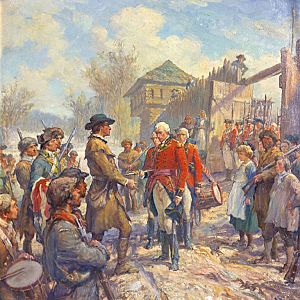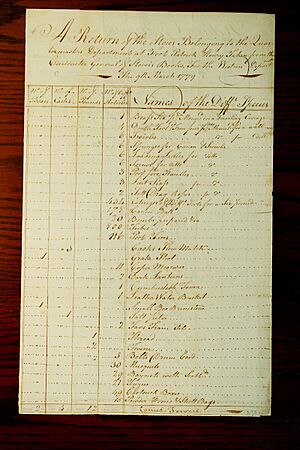Forts of Vincennes, Indiana facts for kids
Quick facts for kids Fort Vincennes, Fort Sackville, Fort Patrick Henry |
|
|---|---|
| Vincennes, Indiana | |
| Type | Fort |
| Site information | |
| Controlled by | |
| Site history | |
| Built | 1731-32, 1736 |
| In use | 1732-1736, 1736-1766, 1778-79 |
| Materials | wood |
| Battles/wars | First Battle of Vincennes;Battle of Vincennes |
| Garrison information | |
| Past commanders |
Leonard Helm, Henry Hamilton, George Rodgers Clark |
| Garrison | 90 |
|
Fort Knox II Site
|
|

Reconstructed palisades at the site of Fort Knox II
|
|
| Lua error in Module:Location_map at line 420: attempt to index field 'wikibase' (a nil value). | |
| Nearest city | Vincennes, Indiana |
|---|---|
| Area | 1.8 acres (0.73 ha) |
| Built | 1803 |
| NRHP reference No. | 82000045 |
| Added to NRHP | March 24, 1982 |
Imagine a place where three different countries fought for control! That's what happened in Vincennes, Indiana, during the 1700s and early 1800s. French, British, and American forces all built and used forts here. These forts were super important because they were located on the Wabash River. This river was like a highway for trade and travel.
The forts changed names as different countries took over. They played a big part in major conflicts like the French and Indian War, the American Revolutionary War, and the War of 1812. The very last fort was closed down in 1816.
Vincennes was also famous as the capital of the Northwest Territory. A key event happened here in 1811. General William Henry Harrison gathered his troops in Vincennes. They were preparing for a big campaign that led to the Battle of Tippecanoe. Today, you can visit the site of "Fort Knox II." It's a preserved historic site and is listed on the National Register of Historic Places.
Contents
Early Trading Post
Long before the forts, there was a trading post on the Wabash River. A French explorer named Sieur Charles Juchereau set it up in 1702. He and 34 other Canadians wanted to trade for buffalo hides with Native American tribes. In just three years, they collected over 13,000 buffalo hides!
After Juchereau passed away, the trading post was left empty. The French settlers moved away to a place called Mobile, which is now in Alabama. No one knows the exact spot of Juchereau's trading post today. Some historians think it was right where Vincennes is now. Others believe it was about 50 miles south.
Fort Vincennes: French Control
In 1731, a French leader named François-Marie Bissot, Sieur de Vincennes built a fort. This fort was meant to protect the lower Wabash Valley for France. It also helped strengthen friendships and trade with the Miami, Wea, and Piankashaw Native American nations. The fort was named Fort Vincennes in his honor. Sadly, Vincennes died in a conflict in 1735.
In 1736, Louis Groston de Saint-Ange de Bellerive took charge of the fort. He rebuilt it and made it a busy trading hub. He encouraged Canadian traders and Native American people to settle nearby. This helped build stronger relationships. By 1750, the Piankashaw people had a village close to the fort.
France lost control of its lands in North America after the Seven Years' War in 1763. The British took over the territory east of the Mississippi River. In 1764, St. Ange was ordered to leave Fort Vincennes. He handed over command to a local citizen named Drouet de Richerville.
Fort Sackville: British Rule
In 1766, British Lieutenant John Ramsey arrived in Vincennes. He counted the people living there and improved the fort. He renamed it Fort Sackville to honor Lord George Sackville. The area around the fort grew quickly. A unique mix of Native Americans, French, and British people lived and worked together. Fort Sackville was located near where First and Main Streets are today in Vincennes.
After the French and Indian War, the British government didn't have enough money to keep soldiers at all their forts. For ten years, there were no British troops in the Wabash Valley. Fort Vincennes fell apart. The government even ordered everyone to leave Vincennes because of lawlessness. But the residents worked together. They proved they were permanent settlers, not just temporary visitors.
British attention returned on June 2, 1774. The British Parliament passed the Quebec Act. This law made the Province of Quebec much larger. It now included the Ohio and Illinois areas, reaching all the way to the Ohio River. Lieutenant Governor Edward Abbott was sent to Vincennes. He had no soldiers, but he rebuilt Fort Sackville. Abbott soon resigned, saying he didn't get enough support from the British Crown.
In July 1778, Father Pierre Gibault brought exciting news. France had become allies with the new United States! The Canadian residents of Vincennes took control of the empty Fort Sackville. Colonel George Rogers Clark sent Captain Leonard Helm to command the fort. But in December, a British force led by Lieutenant-Governor Henry Hamilton retook Fort Sackville. Captain Helm was captured.
Fort Patrick Henry: American Victory
In February 1779, Lieutenant Colonel George Rogers Clark led 130 men on a tough 180-mile march through the wilderness to Vincennes. When he arrived, the French settlers and Native American allies joined his forces. Together, they recaptured Fort Sackville! Clark sent Hamilton and his British soldiers to jail in Williamsburg, Virginia. Governor Thomas Jefferson held them as prisoners of war. Clark renamed the fort Fort Patrick Henry after the American patriot Patrick Henry.
Clark's goal was to remove the British threat to Virginia's western settlements. After achieving this, he returned to Kentucky. He hoped to gather more troops to attack British-held Fort Detroit, but he wasn't successful. In the spring of 1780, the Virginia troops left the Vincennes fort. Local militia took over its control.
After the American Revolution, many families from Kentucky settled in Vincennes. There was tension between these Americans, the French-led local government, and the Native American people. Virginia Governor Patrick Henry sent George Rogers Clark back to command the militia. Clark arrived in Vincennes in 1786. His attempts to make peace with the local Native Americans didn't work. He also caused problems by taking goods from Spanish traders. This angered the local people and risked a war with Spain. Clark and his men left Vincennes in the spring of 1787, following orders from the new United States government.
Fort Knox I
In 1787, the U.S. army built a new fort a few blocks north of the old one. Major Jean François Hamtramck led this effort. They named it Fort Knox (often called Fort Knox I by historians). It was named after the U.S. Secretary of War. This fort was located where First and Buntin streets are today.
From 1787 to 1803, there was relative peace with the British and most Native American tribes. Fort Knox was the westernmost American military outpost. However, the soldiers at Fort Knox didn't get along well with the local people. In 1796, soldiers were ordered to stay within 100 yards of the fort. Territorial Governor William Henry Harrison asked the Secretary of War for money to build a new fort.
Fort Knox II
In 1803, the government approved $200 to build a new fort. The War Department bought land about three miles north of Vincennes. This spot, called Petit Rocher, had a great view of the Wabash River. This new fort was also called Fort Knox, or Fort Knox II by locals. It was a quiet fort, mostly known for duels and soldiers leaving without permission.
But by 1811, disagreements between Governor Harrison and the Native American leader Tecumseh were growing. Captain Zachary Taylor was put in charge of Fort Knox II. Late in 1811, the fort became very important. Governor Harrison gathered his troops here, both regular army and militia. They prepared for their march to Prophetstown and the Battle of Tippecanoe. After the battle, the troops returned to Fort Knox. Several soldiers died there from their wounds.
In 1813, during the War of 1812, there was a higher chance of Native American attacks on Vincennes. The military decided Fort Knox was too far away to protect the town. So, Fort Knox II was taken apart. Its pieces were floated down the Wabash River. It was then rebuilt just a few yards from where Fort Knox I had been.
Today, the original Fort Knox II site is a preserved state and national historic site. It's near Ouabache State Park on the edge of Vincennes. The outline of the old fort is marked with short posts. There are signs that explain its history in a park setting. It was added to the National Register of Historic Places in 1982.
Fort Knox Abandoned
After the War of 1812, the threat of attacks decreased again. The problems between residents and soldiers returned. Since Native American territories moved farther north, the army decided to move the soldiers. They went to Fort Harrison, near Terre Haute, where troops had won a victory a few years earlier.
On February 10, 1816, the soldiers were ordered to Fort Harrison. Fort Knox was then abandoned. Within weeks, the people of Vincennes had taken all the usable materials from the fort.
Commanders of Fort Knox
| Name | Command Date | Notes |
|---|---|---|
| Major John Hamtramck | 1787 | |
| Captain Thomas Pasteur | 1796 | Ordered soldiers to stay within 100 yards of the fort. |
| Captain Honest F. Johnston | 1798 | |
| Captain Cornelius Lyman | 1802 | Started building Fort Knox II. |
| Captain George Rogers Clark Floyd | 1809 | Arrived with more soldiers due to Native American unrest. |
| Captain Thornton Posey | 1811 | Arrived with more soldiers to help finish Fort Knox II. |
| Captain Zachary Taylor | 1811 | Took command after Captain Posey left. |
| Lieutenant Josiah Bacon | 1811 | Stayed in temporary command due to an injury. |
| Lieutenant Thomas H. Richardson | 1813 | Led the rebuilding of Fort Knox III. |
| Major John Chunn | 1814 | Ordered to abandon Fort Knox in 1816. |
Images for kids




